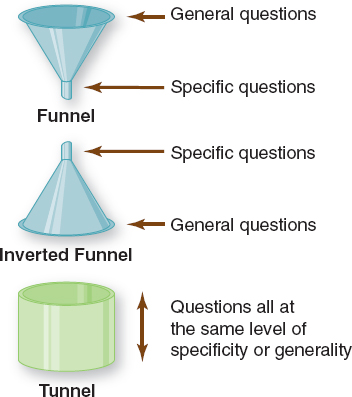Question Sequence

The order in which the questions are asked can affect both the accomplishment of the interview’s goals and the comfort level of the interviewee. There are three main “shapes” that guide the ordering of questions: the funnel, inverted funnel, and tunnel sequences (Figure A.1).
In the funnel sequence, the interviewer starts with broad, open-
- “What do you think about children playing competitive sports?” (general)
- “What disadvantages have you witnessed?” (specific)
- “What constraints would you advocate for young players?” (very specific)
The inverted funnel sequence starts with narrow, closed questions and moves to more open-
- “Did you perform a Mozart piece for your piano recital in junior high school?” (very specific)
- “What other classical compositions are you comfortable playing?” (specific)
- “How did you feel about taking piano lessons as a child?” (general)
In the tunnel sequence, all of the questions are at one level. The tunnel sequence works particularly well in polls and surveys. A large tunnel would involve a series of broad, open-
- “Have you attended any multicultural events on campus?” (specific)
- “Have you attended any sporting events?” (specific)
- “Have you attended any guest lectures?” (specific)